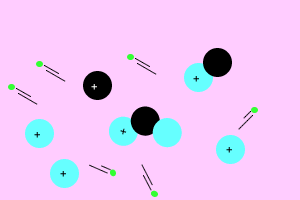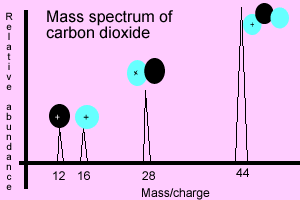Mass spectrum of
carbon dioxide
The animation on the right shows how the carbon dioxide molecule is ionised in a mass spectrometer. Under extreme electron bombardment the molecule decomposes into distinct charged fragments (ions). The molecule will always shatter into the same fragments when subjected to the right amount of high energy electron bombardment. Every molecule shatters in its own unique way and therefore mass spectrometry can be used to identify chemical substances present in unknown samples. The mass spectrum is the molecule's identifying chemical fingerprint, the bigger the molecule the more complex the spectrum becomes.

Lets
look at carbon dioxide and the way it behaves in a mass spectrometer to
give a unique spectrum.
Carbon dioxide is released into the ionising chamber where high energy electron collisions are enough to remove bonding and non-bonding electrons from the molecule and shatter it into different charged fragments. Scan the image on the right to reveal the unique fragments that the carbon dioxide molecule shatters into.
Carbon dioxide is released into the ionising chamber where high energy electron collisions are enough to remove bonding and non-bonding electrons from the molecule and shatter it into different charged fragments. Scan the image on the right to reveal the unique fragments that the carbon dioxide molecule shatters into.

Each
charged fragment will produce its own peak in the spectrum.
